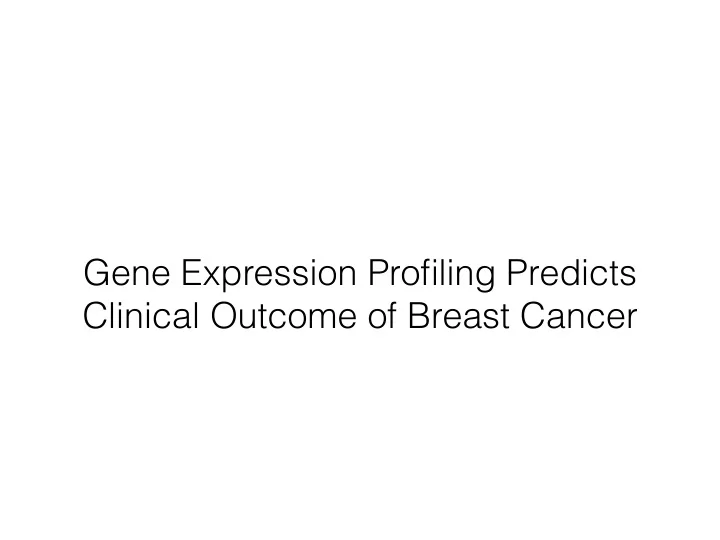

Gene Expression Profiling Predicts Clinical Outcome of Breast Cancer
Motivation Observation : breast-cancer patients at same stage have different outcomes Problem : existing outcome predictors are poor - lymph nodes - histological grade Goals : - identify categories of breast cancer - predict outcome based on gene expression - decide therapy accordingly
Treatment “Chemotherapy or hormonal therapy reduces risk of distant metastases by approximately one-third; however 70-80% of patients receiving this treatment would have survived without it.” A main contribution of this method is lower false positives.
Result Overview
Result Overview gets therapy needs therapy
Result Overview needs therapy does not need therapy 100 100 Recommend Therapy % Recommend Therapy % 75 75 50 50 25 25 0 0 St Gallen NIH Prognosis Profile St Gallen NIH Prognosis Profile
Study 1. unsupervised clustering, look for tumor categories 2. supervised learning, find prognosis reporter genes
Study 1. unsupervised clustering, look for tumor categories 2. supervised learning, find prognosis reporter genes
Unsupervised Hierarchical Clustering: Dendogram http://youtu.be/XJ3194AmH40?t=5m
2 categories
4 categories
page 531
page 531 co-regulates with ER- α
page 531
page 531 co-regulates with lymphocytic infiltrate
page 531
Study 1. unsupervised clustering, look for tumor categories 2. supervised learning, find prognosis reporter genes
Study 1. unsupervised clustering, look for tumor categories 2. supervised learning, find prognosis reporter genes
Method Start with 25K genes (some double counting) From these, identify 5K that are significantly regulated From these, identify 231 significantly associated with disease outcome From these, identify 70 as classification features
Supervised Learning on Prognosis Signatures
page 532 Training Data (78 tumors)
page 532 Test Data (19 tumors)
Supervised Learning on ER and BRCA1 Signatures
page 533
page 533
Summary New ideas (for 826): - new label: clinical outcome - use of unsupervised learning - accuracy vs. sensitivity tradeoffs
Recommend
More recommend